Effect of Coniferous Tree–Shrub Mixtures on Traffic Noise Reduction in Public Spaces
Abstract
1. Introduction
- What are the morphological parameters of mixed green spaces that affect noise reduction?
- How does planting density affect noise reduction?
- What are the planting patterns of coniferous plantations and their predictive models of impact noise reduction in summer and winter?
2. Materials and Methods
2.1. Research Site
2.2. Measurement Method
3. Results
3.1. Noise-Reduction Effects of Coniferous Trees and Shrubs with Different Planting Patterns in Summer and Winter
3.1.1. Noise Mapping
3.1.2. Noise Reduction Effect
3.2. Influence of Planting Density and Gaps on Noise-Reduction Effect
3.2.1. Planting Density
3.2.2. Planting Gaps
3.3. Influence of Morphologic Parameters on the Noise-Reduction Effect of Mixture Green Spaces
3.4. Prediction Model for the Noise-Reduction Effect of a Mixture of Coniferous Trees and Shrubs
(R2 = 0.618)
4. Discussion
4.1. Scope of Research Application and Its Expansion Possibility
4.2. Noise-Reduction Strategies in Urban Greenery Planning
4.3. Application in Urban Planning and Design
5. Conclusions
Author Contributions
Funding
Data Availability Statement
Conflicts of Interest
Appendix A
| Site Number | DBH, m | MHB, m | Height Trees, m | Height Shrubs, m | Crown Trees, m | Crown Shrubs, m | Horizontal Distance, m | Vertical Distance, m | Width of the Roadway, m | Sidewalk Size, m | Density Planting % | Traffic Volume Summer Vehicles/ min | Traffic Volume Winter Vehicles/ min | Number of Lanes |
|---|---|---|---|---|---|---|---|---|---|---|---|---|---|---|
| 1-A | 0.39 | 0.62 | 2.65 | 0.92 | 2.93 | 1.4 | 0.66 | 2.94 | 9.60 | 7.3 | 52.95 | 26 | 22.2 | 3 |
| 2-B | 0.33 | 0.66 | 3.06 | 0.7 | 2.28 | 1.1 | 4.83 | 1.5 | 8.7 | 4.7 | 20.65 | 24.8 | 8.2 | 3 |
| 3-B | 0.058 | 0.66 | 2.85 | 0.7 | 2.31 | 1.1 | 4.8 | 1.5 | 8.7 | 4.7 | 20.65 | 22.8 | 9.4 | 3 |
| 4-C | 0.133 | 1.02 | 4.96 | 1.18 | 3.78 | 1.9 | 1.23 | 1.3 | 11.00 | 4.1 | 62.5 | 10 | 23 | 3 |
| 5-C | 0.11 | 1.07 | 4.8 | 1.02 | 4.1 | 3.55 | 2.7 | 2.05 | 11.00 | 4.1 | 51 | 26 | 21 | 3 |
| 6-C | 0.15 | 1.21 | 3.83 | 1.13 | 2.8 | 3.03 | 0.81 | 1.36 | 11.00 | 4.1 | 50 | 26 | 22 | 3 |
| 7-D | 0.137 | 1.04 | 6.21 | 0.75 | 3.5 | 0.68 | 1.65 | 2.49 | 9.60 | 2.5 | 37 | 26 | 23.8 | 3 |
| 8-E | 0.065 | 0.18 | 3.5 | 1 | 2.6 | 2.1 | 3.76 | 0.26 | 9.4 | 0 | 83 | 2 | 2 | 1 |
| 9-F | 0.033 | 0.031 | 3.76 | 3.3 | 1.83 | 1.76 | 2.26 | 3.9 | 3.6 | 7 | 5.28 | 87 | 16.6 | 1 |
| 10-F | 0.035 | 0.1 | 3.2 | 3.9 | 1.9 | 2.03 | 2.1 | 2.16 | 3.6 | 7 | 7 | 33.8 | 17.6 | 1 |
| 11-F | 0.33 | 0.04 | 4.03 | 3.5 | 1.93 | 1.73 | 2.56 | 1.86 | 3.6 | 7 | 11.16 | 5.8 | 12 | 1 |
| 12-G | 0.08 | 0.31 | 3.46 | 1.2 | 0.76 | 1.8 | 1.0 | 1.16 | 10.5 | 0 | 89 | 7 | 10.8 | 2 |
| 13-G | 0.065 | 0.15 | 1.32 | 0.88 | 4.3 | 1.24 | 1.28 | 3 | 10.5 | 0 | 45.33 | 8.8 | 8.6 | 2 |
| 14-H | 0.075 | 0.05 | 2.6 | 0.93 | 1.16 | 1.4 | 0.07 | 1.26 | 10.5 | 0 | 54.33 | 8 | 10.8 | 2 |
| 15-H | 0.04 | 0.05 | 1.63 | 1.1 | 1.2 | 0.9 | 0.18 | 1.46 | 10.5 | 0 | 37.6 | 26.2 | 27 | 2 |
| 16-I | 0.08 | 0.15 | 2.5 | 0.44 | 2 | 1.33 | 4.66 | 7.43 | 9.6 | 5 | 99.5 | 28 | 30 | 3 |
| 17-I | 0.066 | 0.11 | 1.68 | 1 | 3.36 | 1.53 | 2 | 0.66 | 9.6 | 5 | 99.7 | 26.4 | 28 | 3 |
| 18-I | 0.056 | 0.2 | 3.5 | 1.5 | 2.43 | 1.3 | 1.5 | 0.66 | 9.6 | 5 | 99.5 | 23.6 | 25.8 | 3 |
| Site Number | Planting Patterns | Trees | Shrubs | Weather °C Sunny | Air Humidity, % | Width of Research Point, m | Leq dB(A) | Leq Max dB(A) | Leq Min dB(A) |
|---|---|---|---|---|---|---|---|---|---|
| 1-A | Taffy | Juniperus chinensis | Horizontal juniper | 28 | 77 | 10 | 74.3 | 93.2 | 59.8 |
| 2-B | Abreast | Picea pungens | Juniperus | 28 | 77 | 10 | 74.6 | 83.8 | 60 |
| 3-B | Abreast | Picea pungens | Juniperus | 28 | 77 | 10 | 74.3 | 91.3 | 58.4 |
| 4-C | Taffy | Picea abies | Juniperus | 28 | 74 | 5 | 69.3 | 78.9 | 56.5 |
| 5-C | Abreast | Picea abies | Juniperus | 28 | 74 | 5 | 70.4 | 83.6 | 55.6 |
| 6-C | Abreast | Picea abies | Juniperus | 18 | 74 | 5 | 71.6 | 82.2 | 58.0 |
| 7-D | Abreast | Picea pungens | Thuja occidentalis | 28 | 74 | 15 | 69.8 | 80.5 | 57.7 |
| 8-E | Taffy | Rocky Juniper Blue Arrow | Juniperus sabina, Horizontal juniper, scaly blue juniper | 24 | 85 | 15 | 65.6 | 83.7 | 60.8 |
| 9-F | Abreast | Thuja occidentalis Columna | Cotoneaster lucidus, Thuja occidentalis Globosa, Juniperus sabina, Thuja occidentalis | 27 | 85 | 15 | 54.8 | 86 | 41.1 |
| 10-F | Abreast | Picea abies | Thuja occidentalis | 27 | 85 | 15 | 55.8 | 86 | 43.2 |
| 11-F | Abreast | Picea abies | Thuja occidentalis | 27 | 85 | 15 | 56.4 | 86 | 42.5 |
| 12-G | Taffy | Picea abies | Thuja occidentalis | 27 | 84 | 15 | 67.4 | 90.5 | 57.2 |
| 13-G | Taffy | Mountain pine (Pinus mugo), Picea pungens Glauca Globosa, Thuja occidentalis Columna | Juniperus horizontalis Blue Chip, Thuja occidentalis f. Globosa | 27 | 84 | 15 | 71.5 | 88.1 | 61.3 |
| 14-H | Taffy | Mountain pine (Pinus mugo), Picea pungens Glauca Globosa, Juniper Scopulorum | Juniperus sabina, Horizontal juniper, scaly blue juniper. | 27 | 84 | 15 | 66.5 | 93.6 | 55.1 |
| 15-H | Taffy | Picea abies, Picea pungens Glauca Globosa | Juniperus sabina, Horizontal juniper, scaly blue juniper, Thuja occidentalis Globosa | 27 | 84 | 15 | 66.3 | 94.4 | 54.2 |
| 16-I | Taffy | Picea abies | Horizontal juniper | 25 | 84 | 10 | 75.1 | 96.3 | 55.9 |
| 17-I | Taffy | Picea abies | Horizontal juniper | 25 | 84 | 10 | 76.1 | 96.2 | 55 |
| 18-I | Taffy | Picea abies, Picea pungens, Mountain pine (Pinus mugo) | Thuja occidentali, Horizontal juniper | 25 | 84 | 10 | 74.1 | 96.0 | 54.9 |
| Site Number | Snow Density, kg/m | Snow Characteristics | Weather, °C | Height of Snow Cover on the Ground, cm | The Size of the Snow on the Branches, cm | Li dB(A) | Lr dB(A) | ΔL dB |
|---|---|---|---|---|---|---|---|---|
| 1-A | 284 | freshly fallen settled snow | −5 | 1 | 6.3 | 70.5 | 58.17 | 12.33 |
| 2-B | 285 | freshly fallen settled snow | −5 | 4 | 3 | 80.5 | 54.29 | 26.21 |
| 3-B | 285 | freshly fallen settled snow | −5 | 4 | 5.5 | 70.4 | 49.8 | 20.6 |
| 4-C | 286 | freshly fallen settled snow | −5 | 4 | 3.1 | 66.5 | 57.8 | 8.7 |
| 5-C | 286 | freshly fallen settled snow | −5 | 4 | 3.6 | 68.6 | 57.1 | 11.5 |
| 6-C | 286 | freshly fallen settled snow | −5 | 3.8 | 3 | 80.5 | 63.1 | 17.4 |
| 7-D | 283 | freshly fallen settled snow | −5 | 3.8 | 3.6 | 75.1 | 54.49 | 20.61 |
| 8-E | 168 | wet freshly fallen snow | −2 | 5 | 3.6 | 65.1 | 61.4 | 3.7 |
| 9-F | 173 | wet freshly fallen snow | 0 | 3 | 1 | 74.6 | 57.81 | 16.79 |
| 10-F | 173 | wet freshly fallen snow | 0 | 3 | 1.26 | 64.2 | 59.4 | 4.8 |
| 11-F | 173 | wet freshly fallen snow | 0 | 3 | 18 | 78.6 | 56.9 | 21.7 |
| 12-G | 174 | wet freshly fallen snow | 0 | 3 | 17.4 | 59.5 | 53 | 6.5 |
| 13-G | 174 | wet freshly fallen snow | 0 | 7 | 24.75 | 64.8 | 54 | 10.8 |
| 14-H | 173.1 | wet freshly fallen snow | −1 | 7 | 4.75 | 72.3 | 55.7 | 16.6 |
| 15-H | 173.1 | wet freshly fallen snow | −1 | 5 | 41 | 71.3 | 54.9 | 16.4 |
| 16-I | 175 | wet freshly fallen snow | −1 | 5 | 24 | 66.1 | 57.7 | 8.4 |
| 17-I | 175 | wet freshly fallen snow | −1 | 5 | 21 | 70.9 | 58.2 | 12.7 |
| 18-I | 175 | wet freshly fallen snow | −1 | 5 | 24.2 | 78.6 | 56.9 | 21.7 |
References
- Sordello, R.; Flamerie, F.; Livoreil, B.; Vanpeene, S. The Impact of Noise Pollution on Ecosystems and Biodiversity. Environ. Evid. 2019, 8, 1–7. [Google Scholar] [CrossRef]
- González, D.M.; Morillas, J.M.B.; Rey-Gozalo, G. Effects of noise on pedestrians in urban environments where road traffic is the main source of sound. Sci. Total Environ. 2023, 857, 159406. [Google Scholar] [CrossRef]
- Dye, C. Health and urban living. Science 2008, 319, 766–769. [Google Scholar] [CrossRef]
- Eurofound. European Quality of Life Survey 2016: Quality of Life, Quality of Public Services, and Quality of Society; Publications Office of the European Union: Luxembourg, 2017. [Google Scholar]
- Laxmi, V.; Thakre, C.; Vijay, R. Evaluation of noise barriers based on geometries and materials: A review. Environ. Sci. Pollut. 2022, 29, 1729–1745. [Google Scholar] [CrossRef] [PubMed]
- Lercher, P. Environmental noise and health: An integrated research perspective. Environ. Int. 1996, 22, 117–129. [Google Scholar] [CrossRef]
- Oquendo-Di Cosola, V.; Navacerrada, M.Á.; Ruiz-García, L.; Olivieri, F. Evaluating the Acoustic Absorption of Modular Vegetation Systems: Laboratory and Field Assessments Using an Impedance Gun. Buildings 2025, 15, 389. [Google Scholar] [CrossRef]
- Alkadri, M.F.; Yuliana; Hadini, M.H.; Jonatan, S.A.; Yolanda, A.; Desiana, P.A.; Sa’diah, N.F.; Susanto, D.; Istiani, N.F.F.; Suryanegara, M. Exploring Uncharted Territories in a Vertical Greening System: A Systematic Literature Review of Design, Performance, and Technological Innovations for Urban Sustainability. Buildings 2025, 15, 1102. [Google Scholar] [CrossRef]
- Ow, L.F.; Ghosh, S. Urban Cities and Road Traffic Noise: Reduction Through Vegetation. Appl. Acoust. 2017, 120, 15–20. [Google Scholar] [CrossRef]
- Van Renterghem, T.; Attenborough, K.; Maennel, M. Measured Light Vehicle Noise Reduction by Hedges. Appl. Acoust. 2014, 78, 19–27. [Google Scholar] [CrossRef]
- Samara, T.; Tsitsoni, T. The effects of vegetation on reducing traffic noise from a city ring road. Noise Control Eng. J. 2011, 59, 68–74. [Google Scholar] [CrossRef]
- Fang, C.-F.; Ling, D.-L. Investigation of the noise reduction provided by tree belts. Landsc. Urban Plan. 2003, 63, 187–195. [Google Scholar] [CrossRef]
- Van Renterghem, T. Guidelines for optimizing road traffic noise shielding by non-deep tree belts. Ecol. Eng. 2014, 69, 276–286. [Google Scholar] [CrossRef]
- Van Renterghem, T.; Botteldooren, D.; Verheyen, K. Road traffic noise shielding by vegetation belts of limited depth. J. Sound Vib. 2012, 331, 2404–2425. [Google Scholar] [CrossRef]
- Kragh, J. Road traffic noise attenuation by belts of trees. J. Sound. Vib. 1981, 74, 235–241. [Google Scholar] [CrossRef]
- Koptseva, E.M.; Zaytsev, A. Noise Reduction Properties of Urban Green Spaces in Saint-Petersburg. In Green Technologies and Infrastructure to Enhance Urban Ecosystem Services; Springer: Cham, Switzerland, 2020; p. 181964298. [Google Scholar]
- Li, M.; Van Renterghem, T.; Kang, J.; Verheyen, K.; Botteldooren, D. Sound absorption by tree bark. Appl. Acoust. 2020, 165, 107328. [Google Scholar] [CrossRef]
- Yu, L.; Kang, J. Factors influencing the sound preference in urban open spaces. Appl. Acoust. 2010, 71, 622–633. [Google Scholar] [CrossRef]
- ISO 1996-2:2007; Acoustics—Description, Measurement and Assessment of Environmental Noise Part 2: Determination of Environmental Noise Level. International Organization for Standardization: Geneva, Switzerland, 2007.
- Cook, D.; Van Haverbeke, D. Trees and shrubs for noise abatement. In Research Bulletin 246, Historical Materials from University of Nebraska-Lincoln Extension; College of Agricultural Experimental Station: Lincoln, NE, USA, 1971. [Google Scholar]
- Hosseini, S.A.O.; Zandi, S.; Fallah, A.; Nasiri, M. Effects of geometric design of forest road and roadside vegetation on traffic noise reduction. J. For. Res. 2016, 27, 463–468. [Google Scholar] [CrossRef]
- Bashir, I.; Taherzadeh, S.; Shin, H.-C.; Attenborough, K. Sound propagation over soft ground without and with crops and potential for surface transport noise attenuation. J. Acoust. Soc. Am. 2015, 137, 154–164. [Google Scholar] [CrossRef]
- Schaefer, V.J.; Klein, G.J.; de Quervain, M.R. The International Classification for Snow-with Special Reference to Snow on the Ground; Technical Memorandum No. 31; Associate Committee on Soil and Snow Mechanics, National Research Council of Canada: Ottawa, ON, Canada, 1954. [Google Scholar]
- Fricke, F. Sound attenuation in forests. J. Sound Vib. 1984, 92, 149–158. [Google Scholar] [CrossRef]
- Radosavljevic, J.; Vukadinovic, A.; Vasovic, D.; Petkovic, A. Attenuation of Road Traffic Noise by Vegetation in Urban Spaces. An. Univ. Eftimie Murgu Resita Anul 2015, 2, 318–326. [Google Scholar]
- Johnson, J.B. On the application of Biots theory to acoustic wave propagation in snow. Cold Reg. Sci. Technol. 1982, 6, 4960. [Google Scholar] [CrossRef]
- Yu, L.; Kang, J. Modeling subjective evaluation of soundscape quality in urban open spaces: An artificial neural network approach. J. Acoust. Soc. Am. 2009, 126, 1163–1174. [Google Scholar] [CrossRef]
- Li, M.; Wu, Y.; Sun, S.; Zhang, M. A distribution stratege for measuring point positions of street space reducing traffic noise. In Proceedings of the 9th International Building Physics Conference (IBPC 2024), Toronto, ON, Canada, 25–27 July 2024. [Google Scholar]
- Albert, D.G. Acoustic Waveform Inversion with Application to Seasonal Snow Covers. J. Acoust. Soc. Am. 2001, 109, 91101. [Google Scholar] [CrossRef]
- Watson, R.B. On the propagation of sound over snow. J. Acoust. Soc. Am. 1948, 20, 846–848. [Google Scholar] [CrossRef]
- Colbeck, S.C.; Akitaya, E.; Armstrong, R.L.; Gubler, H.; Lafeuille, J.; Lied, K.; McClung, D.M.; Morris, E.M. The International Classification for Seasonal Snow on the Ground; International Commission on Snow and Ice: Boulder, CO, USA, 1990. [Google Scholar]
- Smith, N. Determining the Dynamic Properties of Snow and Ice by Forced Vibration; DTIC Document; Cold Regions Research & Engineering Laboratory: Hanover, NH, USA, 1969. [Google Scholar]
- Mehran, N.; Asghar, F.; Behnam, N. The effects of tree species on reduction of the rate of noise pollution at the edge of hyrcanian forest roads. Environ. Eng. Manag. J. 2015, 14, 1021–1026. [Google Scholar] [CrossRef]
- Burns, S.H. The absorption of sound by pine trees. J. Acoust. Soc. Am. 1979, 65, 658–661. [Google Scholar] [CrossRef]
- Samaneh, K.; Elham, K.; Hamid Reza, N.; Seyed Mahmood, G.; Mina, A. Investigation of the Traffic Noise Attenuation Provided by Roadside Green Belts. Fluct. Noise Lett. 2015, 14, 1550036. [Google Scholar] [CrossRef]
- Papafotiou, M.; Chronopoulos, J.; Tsiotsios, A.; Mouzakis, K.; Balotis, G. The Impact of Design on Traffic Noise Control in an Urban Park. Acta Hortic. 2004, 643, 277–279. [Google Scholar] [CrossRef]
- Ge, J.; Hokao, K. Applying the methods of image evaluation and spatial analysis to study the sound environment of urban street areas. J. Environ. Psychol. 2005, 25, 455–466. [Google Scholar] [CrossRef]
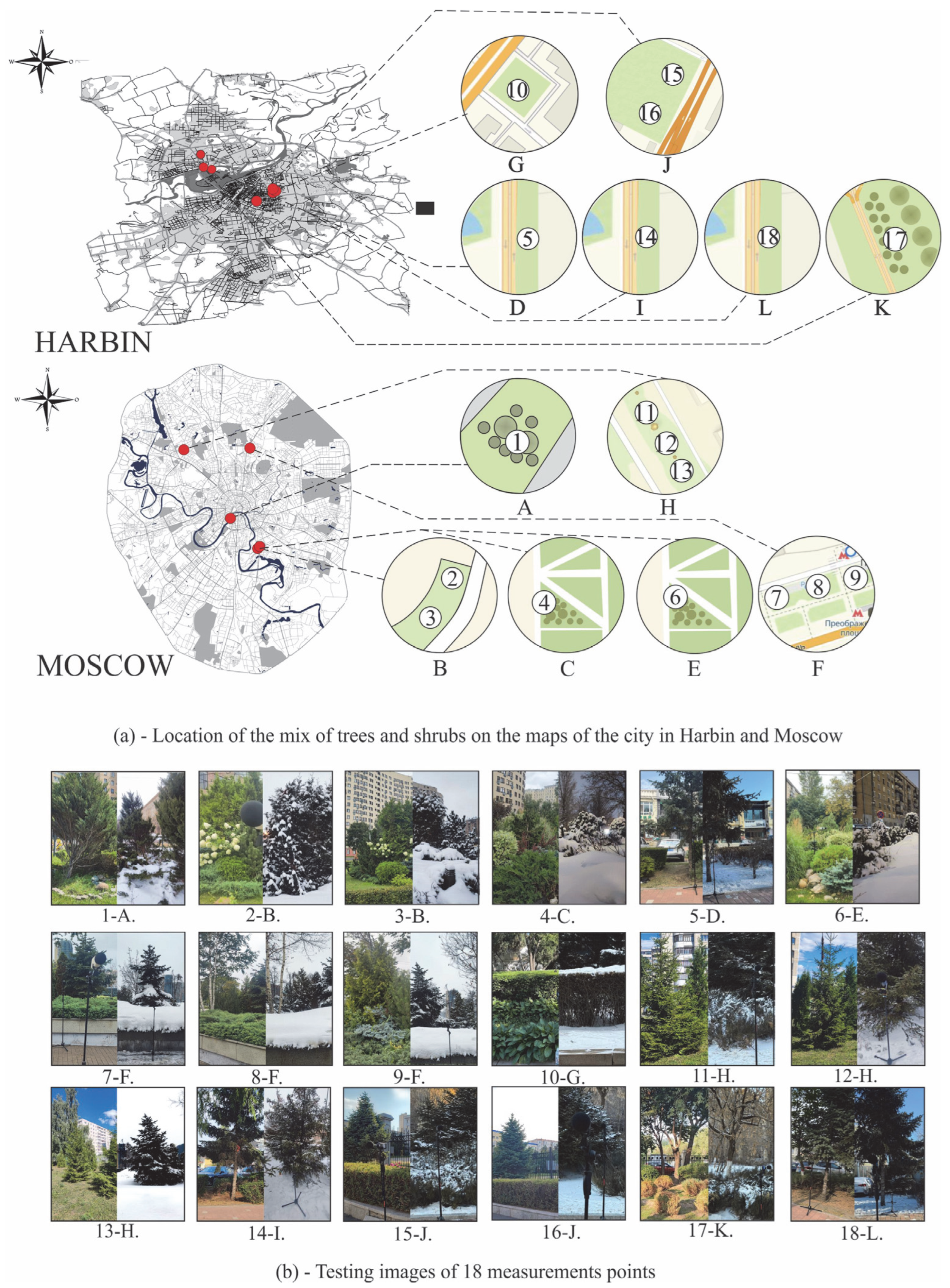
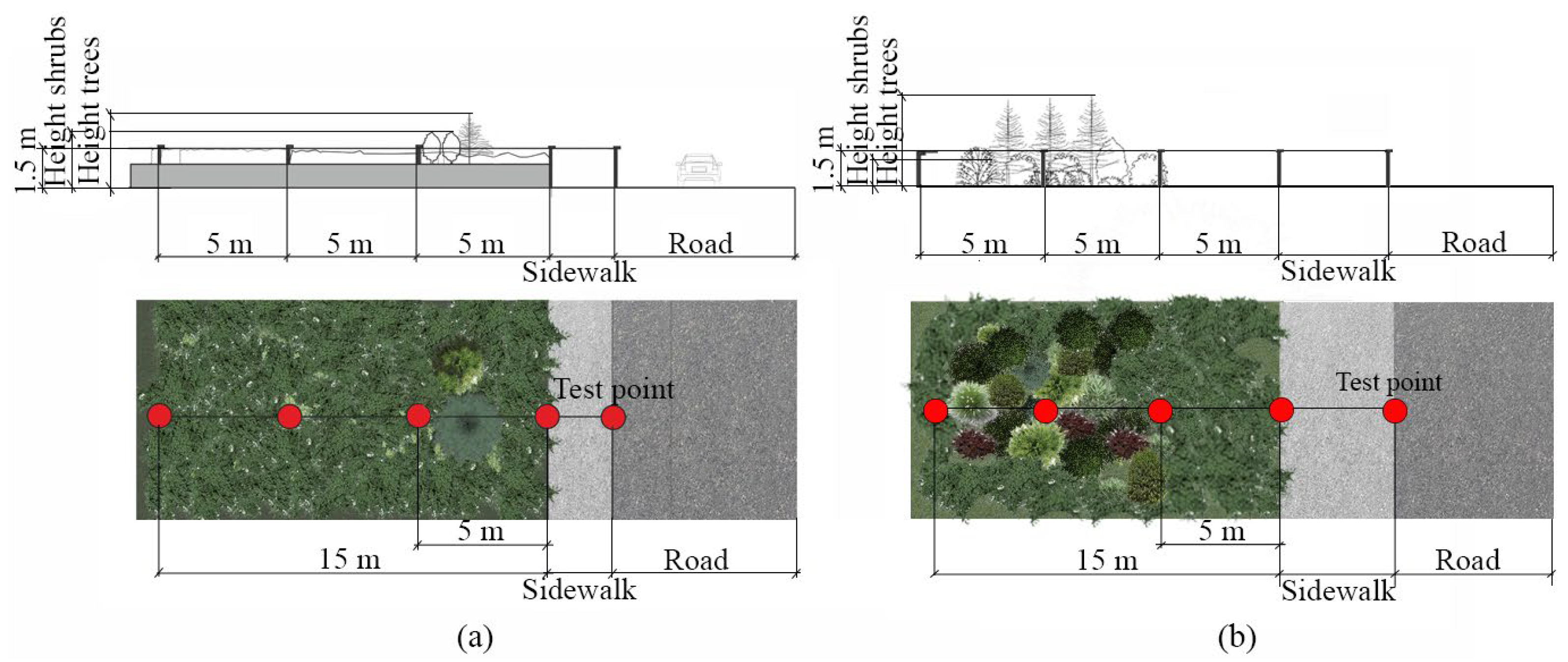
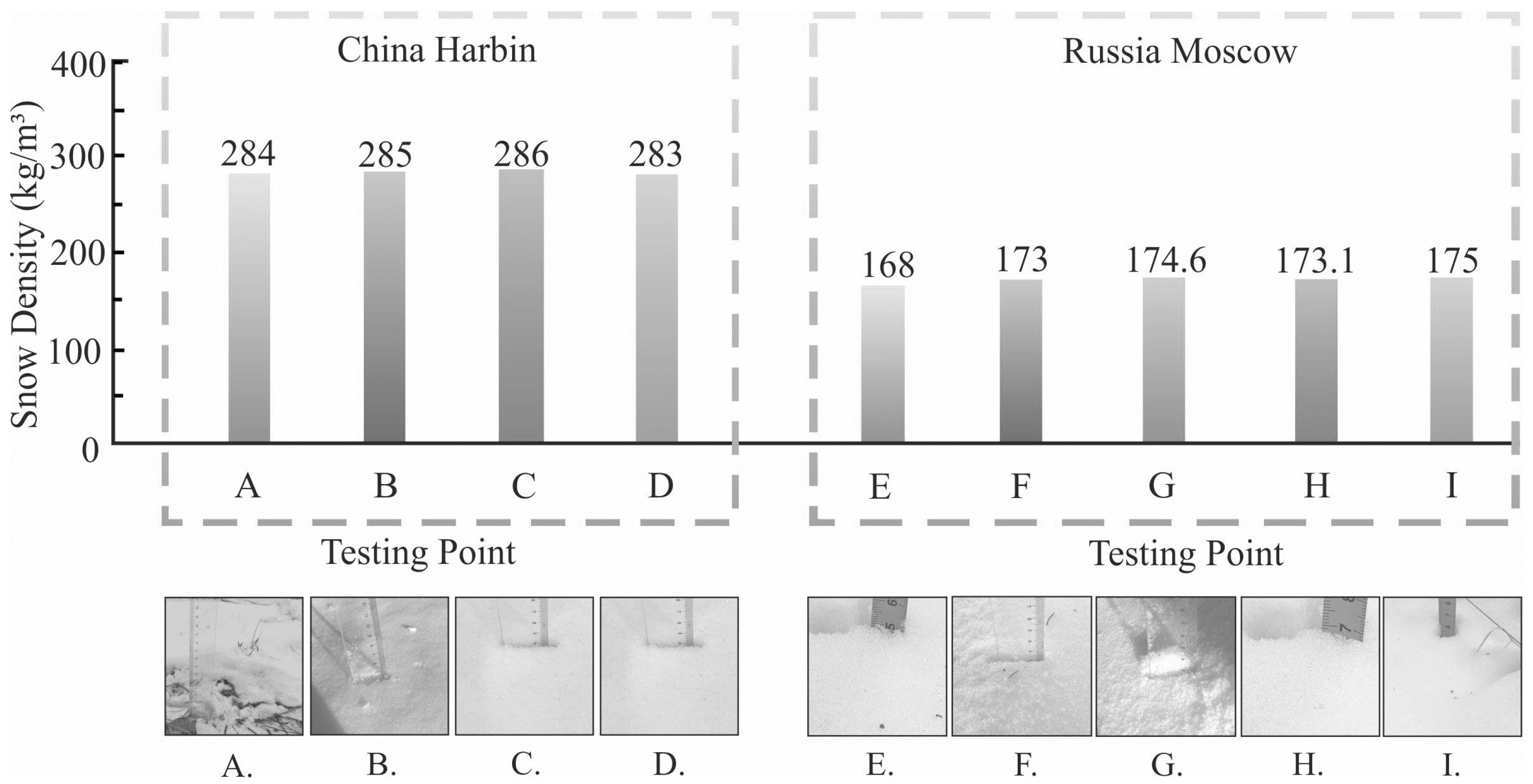

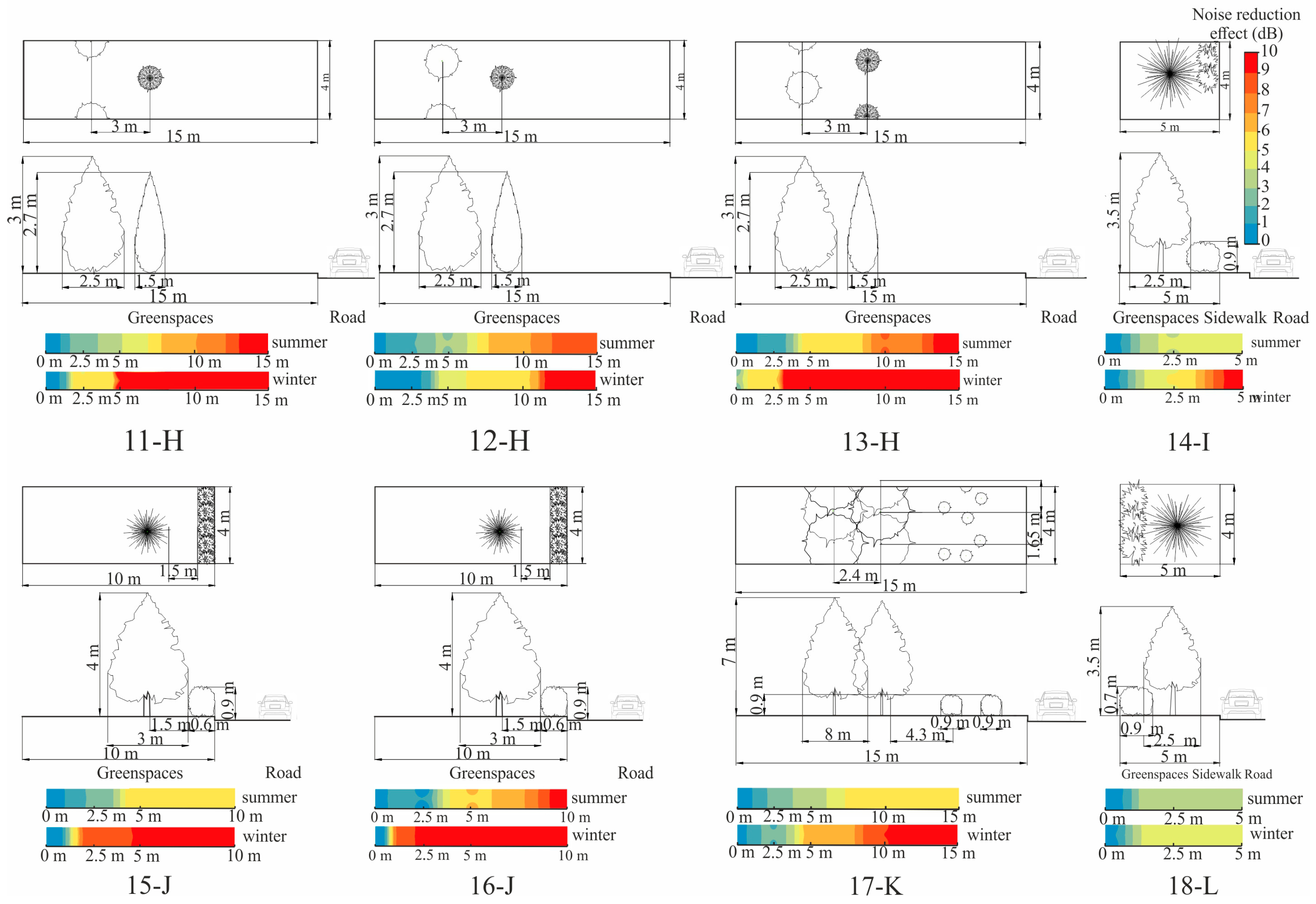
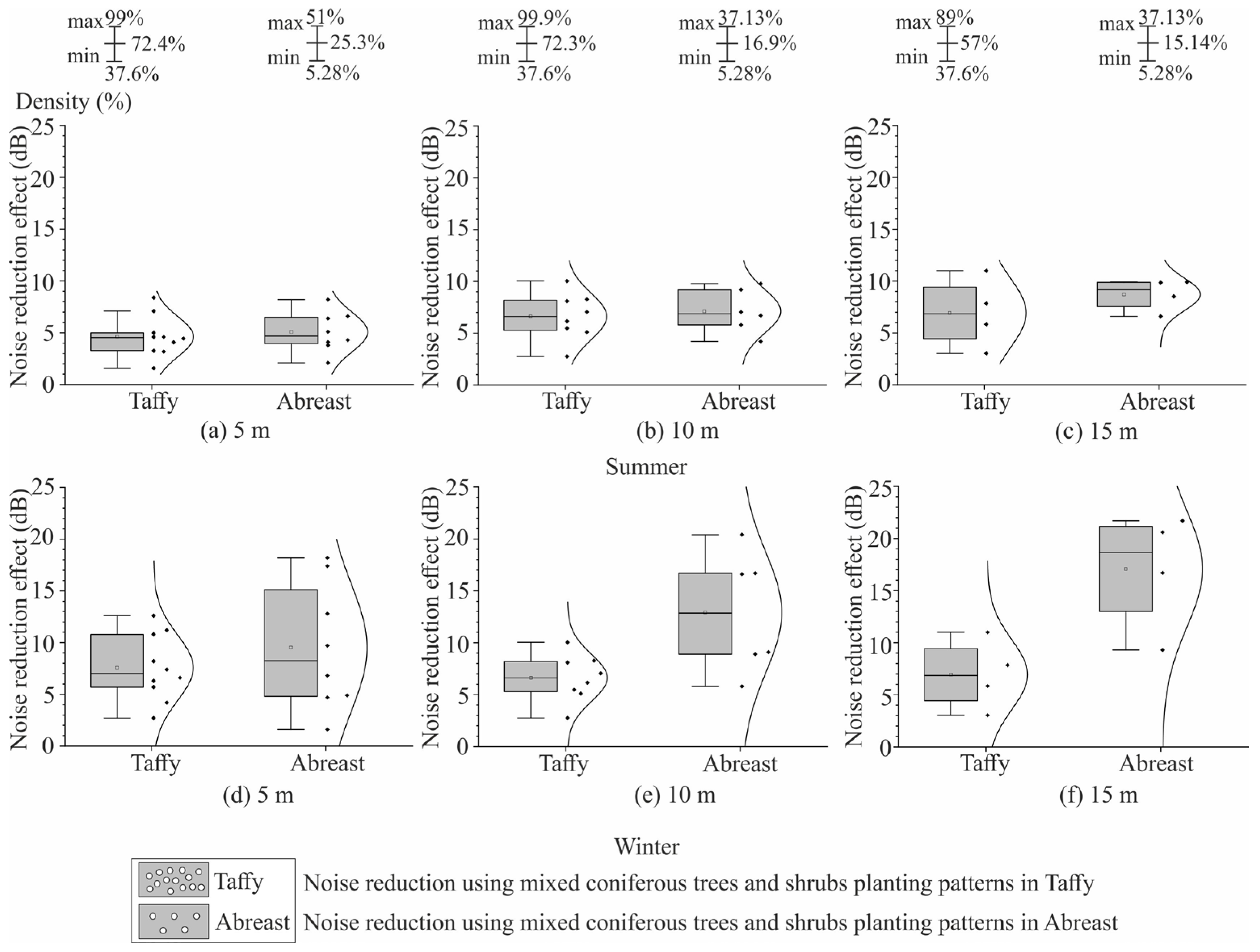
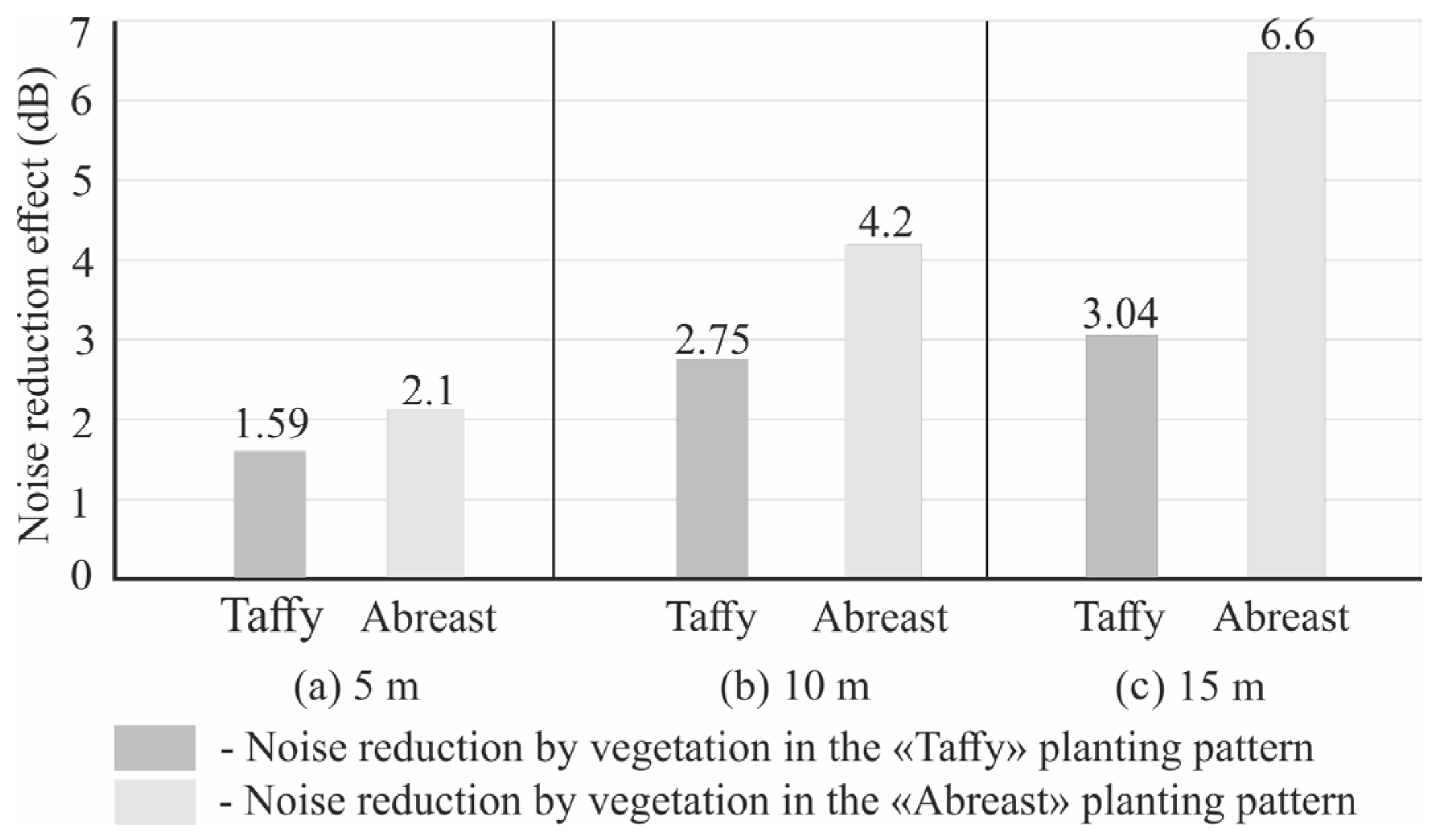
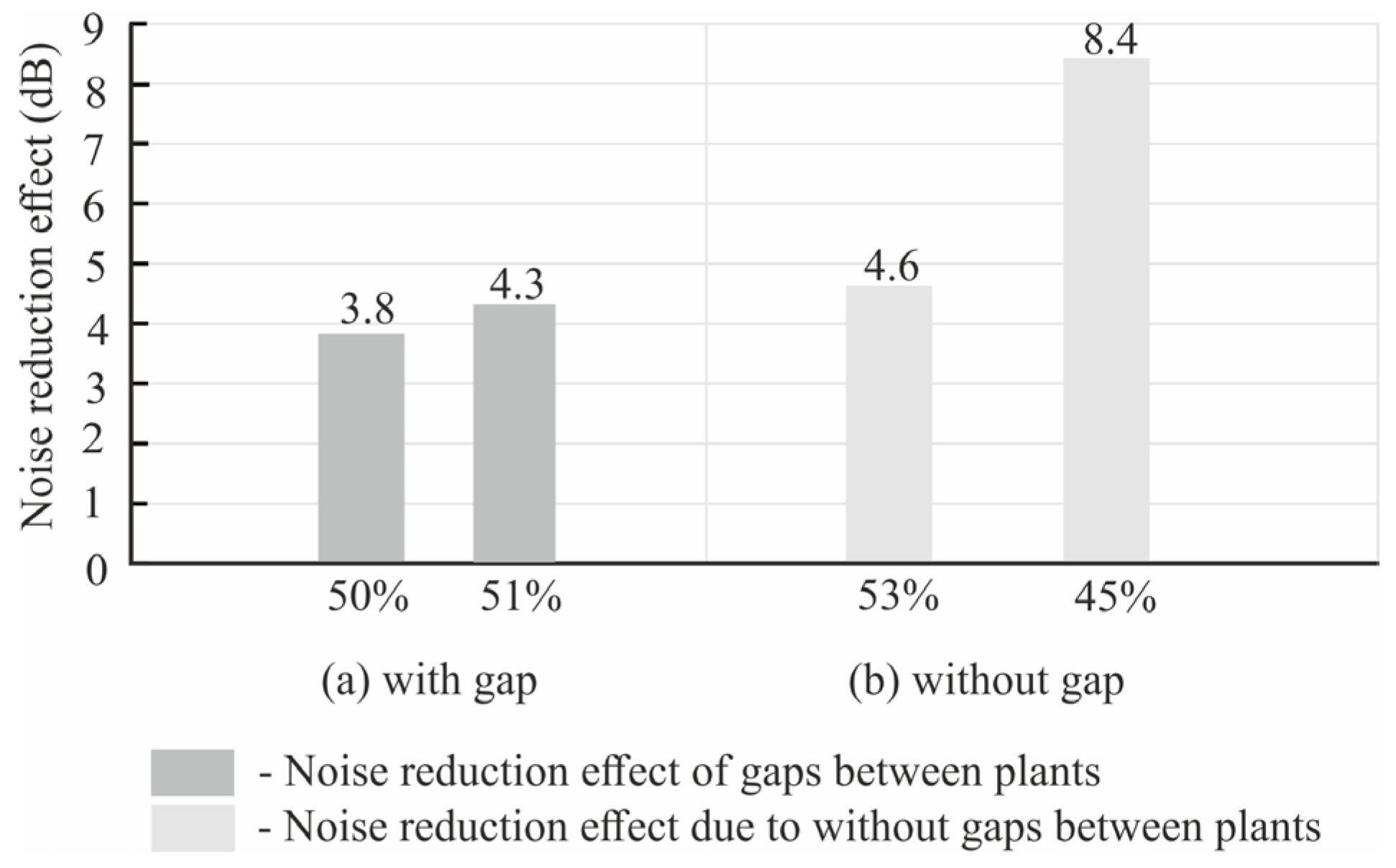
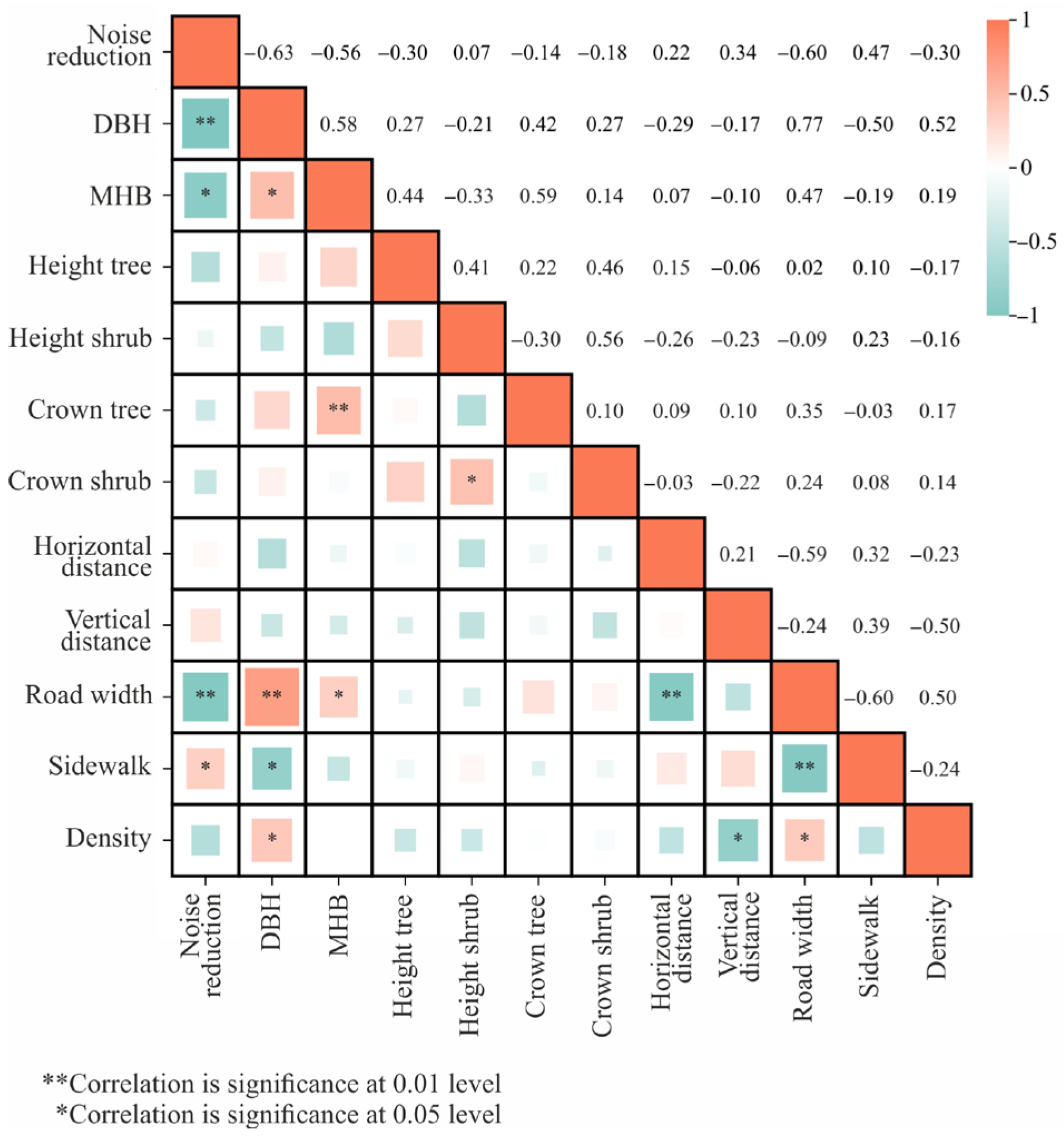

Disclaimer/Publisher’s Note: The statements, opinions and data contained in all publications are solely those of the individual author(s) and contributor(s) and not of MDPI and/or the editor(s). MDPI and/or the editor(s) disclaim responsibility for any injury to people or property resulting from any ideas, methods, instructions or products referred to in the content. |
© 2025 by the authors. Licensee MDPI, Basel, Switzerland. This article is an open access article distributed under the terms and conditions of the Creative Commons Attribution (CC BY) license (https://creativecommons.org/licenses/by/4.0/).
Share and Cite
Meng, Q.; Evgrafova, O.; Li, M. Effect of Coniferous Tree–Shrub Mixtures on Traffic Noise Reduction in Public Spaces. Buildings 2025, 15, 4266. https://doi.org/10.3390/buildings15234266
Meng Q, Evgrafova O, Li M. Effect of Coniferous Tree–Shrub Mixtures on Traffic Noise Reduction in Public Spaces. Buildings. 2025; 15(23):4266. https://doi.org/10.3390/buildings15234266
Chicago/Turabian StyleMeng, Qi, Olga Evgrafova, and Mengmeng Li. 2025. "Effect of Coniferous Tree–Shrub Mixtures on Traffic Noise Reduction in Public Spaces" Buildings 15, no. 23: 4266. https://doi.org/10.3390/buildings15234266
APA StyleMeng, Q., Evgrafova, O., & Li, M. (2025). Effect of Coniferous Tree–Shrub Mixtures on Traffic Noise Reduction in Public Spaces. Buildings, 15(23), 4266. https://doi.org/10.3390/buildings15234266







